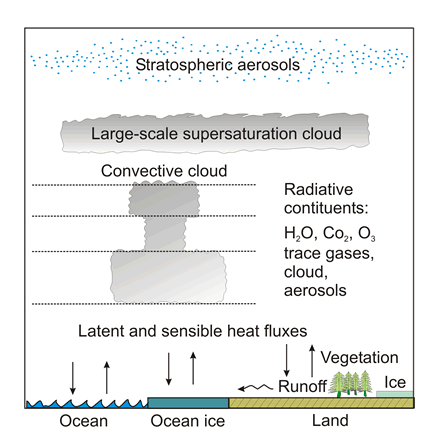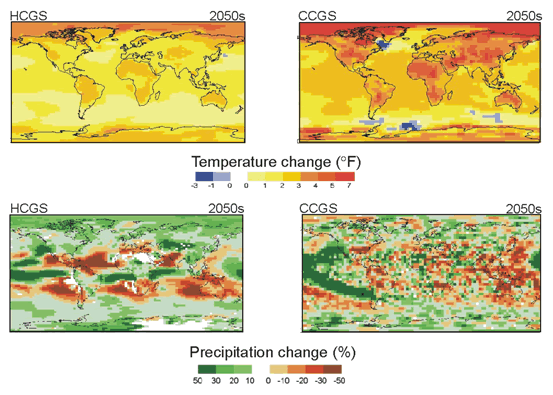|
|
 |  | 
| Print this Brief |
| What
is a global climate model? |
| |
Key
Points
Global climate models (GCMs) are mathematical
formulations of the processes that comprise the climate
system. Climate models can be used to make projections
about future climate and the knowledge gained can
contribute to policy decisions regarding climate
change. An advantage of GCMs is their ability to
perform multiple simulation experiments using different
greenhouse gas emissions scenarios. A disadvantage
of GCMs is their inability to resolve features smaller
than about 50 miles by 50 miles. However, as computing
power continues to increase, models are being constantly
improved.
 |
| Figure 1.
Schematic illustration of GCM structure at
a single
gridbox.Source: Hansen, J., G. Russell,
D. Rind, et al. "Efficient three-dimensional
models for global climate studies: Models
I and II." Monthly Weather Review 111 (4):
609, 662, 1983. |
|
|
 |
How Climate Models Work
Computer climate models are the key tool for simulating
possible future climates. Though there are many types
of models, from simple to complex, three-dimensional
global atmosphere and ocean models hold the most
potential for making accurate climate projections.
These complex and computer-intensive global climate
models have been developed to study global climate
processes and to create projections of possible future
climates. The knowledge gained can contribute to
policy decisions regarding climate change and facilitate
preparations for future climate changes.
GCMs are mathematical formulations of the processes
that comprise the climate system, including radiation,
energy transfer by winds, cloud formation, evaporation
and precipitation of water, and transport of heat
by ocean currents. The model calculations are made
for individual gridboxes on the order of 125 – 300
miles (200 – 500 km) in the horizontal and
vertical dimensions. The equations of the model are
solved
for the atmosphere, land surface, and oceans in each
gridbox over the entire globe using a series of timesteps
(Figure 1).
Projections Made
by Global Climate Models
GCMs are used to simulate the climate
system's future responses to emissions of greenhouse
gases and sulfate aerosols, as well as other human-induced
activities that affect the climate system. Projections
made by GCMs are reflections of the current state
of knowledge of the processes in the climate system,
but they still contain uncertainties. Figure 2 shows
projected changes in temperature and precipitation
in the 2050s using two global climate models, one
developed by the United Kingdom Hadley Centre and
the other by the Canadian Centre for Climate Modeling
and Analysis.
 |
| Figure 2.Projected changes
in temperature and precipitation for the
2050s. Left: United Kingdom Hadley Center.
Right: Canadian Center for Climate Modeling
and Analysis. Source:Rosenzweig and Solecki,
Climate Change and a Global City,
2001. |
|
 |
Advantages and Disadvantages
of Climate Models
An advantage of climate models is their ability
to perform multiple simulation experiments using
different greenhouse gas emissions scenarios. By
performing multiple experiments, with multiple climate
models based on multiple greenhouse gas scenarios,
the range of possible climate outcomes, as well as
the probability of specific outcomes, can be better
understood.
A disadvantage of climate models is that, although
computer power continues to increase rapidly, global
models currently do not resolve features smaller
than about 50 miles x 50 miles. This makes it impossible
to resolve smaller-scale climate features.
The models also simplify or parametrize complex and
often non-linear processes, such as the radiation
effects of high- and low-level clouds or hydrological
processes on the land.
|
References
Flato, G.M., G.J. Boer, W.G. Lee, N.A. McFarlane,
D. Ramsden, M.C. Reader, and A.J. Weaver. 1997. "The
Canadian Centre for Climate Modeling and Analysis global
coupled model and its climate." The Canadian Centre
for Climate Modeling and Analysis. Atmospheric Environment
Service. University of Victoria, BC.
Intergovernmental Panel on Climate Change (IPCC), 2001.
"Working Group I Third Assessment Report." Cambridge
University Press.Cambridge, UK. 881 pp.
Johns, T.E., R.E. Carnell, J.F. Crossley, J.M. Gregory,
J.F.B. Mitchell, C.A. Senior, S.F.B. Tett, and R.A.
Wood. 1997. "The second Hadley Centre coupled ocean-atmosphere
GCM: Model description, spinup, and validation." Climate
Dynamics 13:103-134.
Related Resources:
Print version (factsheet
pdf) |
|
 |
 |
| |
|
|
| |
|
|
|
File last modified: 29 March 2005 |
|
|
For more information about CIESIN and our activities contact CIESIN User Services
Telephone: 1 (845) 365-8988 - FAX:
1 (845) 365-8922
CIESIN is
a center within the Earth
Institute at Columbia University Copyright© 2004-2005. The Trustees of Columbia University in the City of New York.
|
 |
|
| |
|
|
|

